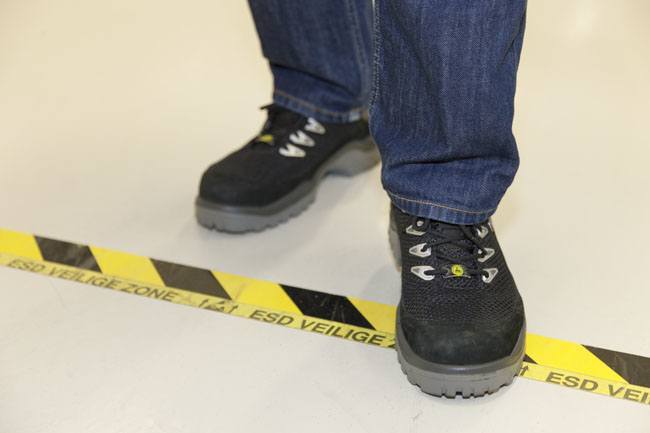Electrical resistance
Electrical resistance is an important characteristic of safety shoes. There are two elements that are also relevant when it comes to making the right choice:
- How well the shoe is able to prevent electrostatic charging by diverting this quickly.
- How well the shoe is able to offer protection from electrical shocks.
If you work with electricity, you can be exposed to voltage. Your shoes must have an electrical resistance that prevents too much electricity from passing through your body.


Electrostatic discharge
Electrostatic discharge is important in situations involving danger of explosion (explosives, chemicals, gases, dust explosion), or if you work with sensitive electronics (microchips, hard drives, etc.). When you move, friction always causes an electrostatic charge in your body. Shoes and clothing that are not conductive (enough) can increase this charge. At a certain point, a discharge occurs. An electrical discharge that is too high or uncontrolled can have extremely uncomfortable and sometimes even serious consequences: an explosion due to spark formation, or damage to the electronic products you work with.
Shoes with low electrical resistance
Shoes with a guaranteed low electrical resistance divert the electrostatic charge in a controlled manner. This prevents the accumulation of an excessively high charge (and an uncontrolled and intense discharge). The wearer must be working on a grounded surface in order to facilitate discharge via the shoe.
Depending on your work situation, you will need shoes with a certain resistance. Bata Industrials offers shoes with two types of electrical resistance: Anti-static and ESD.

Anti-static
Anti-static shoes have an electrical resistance between 0.1 and 1000 MegaOhm (MΩ), measured according to EN 20344: 2011 5 10. This value is a compromise between good protection from electrical shocks and sufficient dissipative capacity. These shoes may be worn in many different work environments.
ESD
ESD (ElectroStatic Dissipative) shoes have an electrical resistance between 0.1 and 100 (MΩ), measured according to BS EN 61340-4-3: 2002 (IEC 61340-4-3:2001). ESD shoes are thus guaranteed to have an extremely low electrical resistance under any conditions in order to prevent a strong, uncontrolled electrostatic charge.
Various classes
To determine whether or not they satisfy the BS EN 61340-4-3: 2002 norm, shoes are tested according to different classes, 1, 2 and 3. The difference between these three classes is the time of conditioning, temperature and humidity. Temperature and humidity (or the moisture content in the shoe) have a major effect on the shoe’s electrical resistance. For class 3, tests are performed using a standard room temperature and humidity. Class 1 is the class with the highest temperature and lowest humidity. When shoes satisfy the class 1 criteria (in other words, an electrical resistance between 0.1 and 100 MΩ), they have a guaranteed low electrical resistance, even under exceptional circumstances.

Additional testing
In addition to the BS EN61340-4-3:2002 norm there is also the IEC 61340-5-1:2007 (IEC 61340-4-5) norm. This norm and testing method is also applied in practical ESD environments. In these tests, the shoes are actually worn by a test subject and the resistance of the shoes is measured on a conductive testing plate. The ESD shoes must also have a resistance below 3.5 x 107 W (which is equal to < 35MW). [/av_textblock] [av_one_half first] [av_image src='https://www.bataindustrials.co.id/wp-content/uploads/2014/02/Anti-static-and-ESD-work-environments.jpg' attachment='1896' align='center' animation='no-animation' link='' target='' custom_class=''] [/av_one_half] [av_one_half] [av_textblock size='' font_color='' color='' custom_class='']
Conductive, insulative and protection from electrical shocks
For extreme situations, there are also shoes that are conductive, insulative, or electrical-shock resistant.
Conductive shoes are shoes that have a resistance below 0.1MΩ, measured according to EN 20344: 2011 5 10. These shoes are actually only necessary in situations in which people work with highly explosive materials such as gunpowder.
Insulative shoes are shoes with an extremely high electrical resistance. These are available according to different criteria, depending on the electrical charge the wearer works with, and environmental factors such as humidity. Insulative shoes are necessary whenever people are at risk of high-voltage shocks (>1000V).
Bata Industrials does not yet offer shoes for these work environments.
[/av_one_half]
Flooring
It is very important to also include the type of flooring when considering all of the different types of electrical resistance of shoes. An ESD shoe cannot function without a suitable surface. For this reason, a separate testing method has been included in several norms which prescribes a measurement that uses a combination of shoe and flooring.

Questions
For questions about electrical resistance of shoes, or the suitability of certain shoes at your workplace, please contact Bata Industrials. We will be happy to provide assistance or help you find the most suitable shoe for your situation.
For more detailed information on the various norms and testing methods for electrical resistance of shoes and flooring see www.nen.nl.

